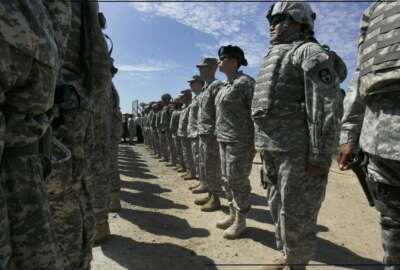
Guard members and reservists are losing out on a key benefit each year
Members of the National Guard and military reserves can have complicated lives. Now it turns out, they often lose out on financial benefits they're entitled to ...
Members of the National Guard and military reserves can have complicated lives. Now it turns out, they often lose out on financial benefits they’re entitled to from lenders. That’s according to a study by the Consumer Financial Protection Bureau. To take a closer look, the Federal Drive with Tom Temin spoke with Charles Goldman, a senior economist and Patrick Brick, a policy analyst at CFPB’s Office of Servicemember Affairs.
Interview transcript:
Tom Temin
What prompted the study to look at what is the benefit to which they are entitled? it’s a legally statutory endorsed break from lending rates, Patrick?Patrick Brick
Sure, so I can briefly outline the [Servicemembers Civil Relief Act (SCRA)]. It was enacted by Congress to provide legal and financial protections for servicemembers on active duty so they can focus on their mission. These protections include the right to reduce interest rate on any preservice obligation to a maximum of 6%. The SCRA also includes other protections against repossession of certain property without a court order, protections against default judgments in civil cases. And protections against home foreclosure without a court order. Eligible service members can also terminate certain residential housing and automobile leases without penalty. They can terminate them early. The interest rate reduction benefit is the main focus of this report, although we do focus to a smaller extent on the protection against repossession. And I should also mention that the Civil Rights Division of the Department of Justice enforces the SCRA and the [Consumer Financial Protection Bureau (CFPB)] office of Servicemember Affairs, monitors the market and refers SCRA violations back to [Department of Justice (DOJ)].Tom Temin
And what did you find in the study then, Charles?Charles Goldman
So we know from other research that these benefits appear to be under utilized, and we found that in this study. So we looked at National Guard and Reserve members using a statistical data source that the bureau purchases, which consists of credit files of Americans. And they’ve been matched to [Department of Defense (DoD)] service records. So we were able to look over the period from 2007 to 2018. And we found that for auto loans, about one in 10 auto loans experienced an interest rate reduction consistent with the law, as Patrick explained it. And for personal loans, about 6% of the loans experienced a reduction. So we see that some servicemembers appear to be benefiting from these legal provisions, but it’s a minority of service members. And as a result, we found that there was about $100 million in potential interest savings over the 11 years that we study that servicemembers could have been entitled to, but did not appear to receive.Tom Temin
And what was the principal reason for this 99% not getting the rates they were entitled to, say for auto loans?Patrick Brick
The major issue that we see Tom, is that companies don’t know if a customer is a servicemember and on active duty, unless they’re provided notification or they voluntarily check the department of defense SCRA website. So servicemembers shoulder the responsibility to notify their creditors and provide a document to support activation. Research has shown that efforts to notify servicemembers of their eligibility have limited success and that many service members drop out of the request process before completing it. And this helps explain our results, that only a small fraction of activated guard reservists are actually receiving interest rate reductions on eligible loans. So our concern is in a rising interest rate environment. These low utilization rates are troubling, because in the coming months and years we expect to see more servicemembers with preservice loans that exceed the 6% threshold. And if it’s unlikely for them to receive the interest rate reduction, as the report suggests, the number of eligible servicemembers missing out on critical interest rate relief and foregone savings may increase.Tom Temin
We’re speaking with Patrick brick, he’s a policy analyst. And with Charles Goldman, senior economist. Both at the Consumer Financial Protection Bureau, until very recently, this was almost maybe a moot matter. Because in terms of car loans, most of the car companies were giving away credit. 0% or 0.9%. Now the pictures change. So is that part of the concern?Patrick Brick
Sure, that’s certainly part of the concern. Again, in this rising interest rate environment, we’re going to see more servicemembers that can benefit from this benefit, so to speak, that service members are entitled to. Although we did see in our research, that there were still a sizable percentage of auto loans over the course of the report range of the report, which was roughly 2007 to 2018. Where auto loans did exceed the 6% threshold, but certainly there are other types of products like mortgages that where the rates are higher now than they were over the report range.Tom Temin
So there’s a potential for this problem to get more variance, in other words.Patrick Brick
Yes, certainly. That’s what we expect to see.Tom Temin
What it also sounds like both the banks and the loners, as well as the people seeking loans, have some homework to do here. So that one, the questions get asked and that they can be answered in a manner that’s sufficient to speed the process up to get it all done. Fair to say?Patrick Brick
I think that’s fair. And I think that is reflected in our recommendations, that there’s kind of a partnership here of solutions that need to be looked at to try to increase the utilization of this benefit. So we talked about, companies have the ability to take steps to respect military borrower rights and ease financial burdens. Particularly again, in this high interest rate environment, to ensure that service members can benefit from the right interest rate reduction. And we make some recommendations to that effect. Notably that creditors can apply SCRA interest rate reductions for all accounts held an institution if a servicemember invokes their right in a single account. So we’re hoping that can become a best practice. We are also recommending that when creditors are able to automatically apply SCRA reductions, that they attempt to do so. Again, utilizing the department defense SCRA website. And then we would like to develop, again, comprehensive and kind of periodic indicators of utilization as this report has attempted to set a baseline for. So that we can overtime gauge if that utilization rate increases?Tom Temin
Do I smell a rulemaking in the offing here?Patrick Brick
I don’t think we’re at that stage, at this point. Again, we’re still just trying to figure out more information and figure out the steps to identify a problem. Where we noticed a low utilization rate, and we’re trying to figure out ways to address that issue.Tom Temin
And Charles will ask you as the economist. You mentioned, there could be $100 million in potential savings not realized earlier. Do we have any sense of the actual overpayments, say relative to what people were entitled to? And do you have any projection of what it might be in the next several years, if these remedies aren’t made?Charles Goldman
Well, it’s difficult for us to be very precise because we’re looking at historical credit files, and they’re captured at the time. And so there are a variety of complications here. For instance, servicemembers have up until six months after their deployment to request this rate reduction, and it must be granted retroactively. And so if a servicemember applied late, the creditor might have refunded them the excess interest paid. But because how our credit files are captured at the time, we wouldn’t be able to see that. So we want to be a little cautious and saying this is our estimate of $100 million in forgone savings. But we also looked at mortgages. As Patrick mentioned, we don’t have quite the same degree of information about the mortgage product. But mortgages represent much larger dollar value. So you think about the amount that borrowers take out.Over the period of time that we did this study. Many mortgages, of course, were below a 6% interest rate. Now mortgage rates have gone up quite a bit. And mortgages are exceeding 6%, some by significant amount. And a mortgage, even a mortgage at 7% or 7.5% could represent a significant savings if the interest rate is lowered to 6%. In addition, the SCRA provides that for, mortgages only, the interest rate protection extends for 12 months after an activation. Unlike the other loan types where it’s only during the activated period. So Guard and Reserve members who have mortgages could actually be entitled to this protection, maybe for two or two and a half years, depending upon the length of their deployment. And so we estimate that there could be much greater potential savings in the mortgage market, especially as we move into a higher interest rate. We don’t have an exact range of the dollar amount, but it’s likely to be much larger than what we estimated for the auto and personal loans at 100 million. So there is potentially quite a bit of money at stake here.
Tom Temin
And finally, Patrick, you mentioned some recommendations. Those recommendations are to whom?Patrick Brick
I think the recommendations that we make on the report are, it’s multifaceted. But most of our recommendations focus on ways that creditors can, on their end, increase the utilization of this, of SCRA interest rate reductions. You can look at the at the history and look really at federal student loans. Because it’s the one exception where the interest rate reduction is automatically applied. And starting in 2014, the Department of Education required federal student loan servicers to check the DoD SCRA website monthly and identify borrowers that were eligible. And as a result, that automatic application led to the dramatic increase in utilization. And that’s one of the proposals that seems to have the possibility to get us to where we want to be in terms of utilization rate.
Copyright © 2024 Federal News Network. All rights reserved. This website is not intended for users located within the European Economic Area.
Tom Temin is host of the Federal Drive and has been providing insight on federal technology and management issues for more than 30 years.
Follow @tteminWFED
Related Stories






